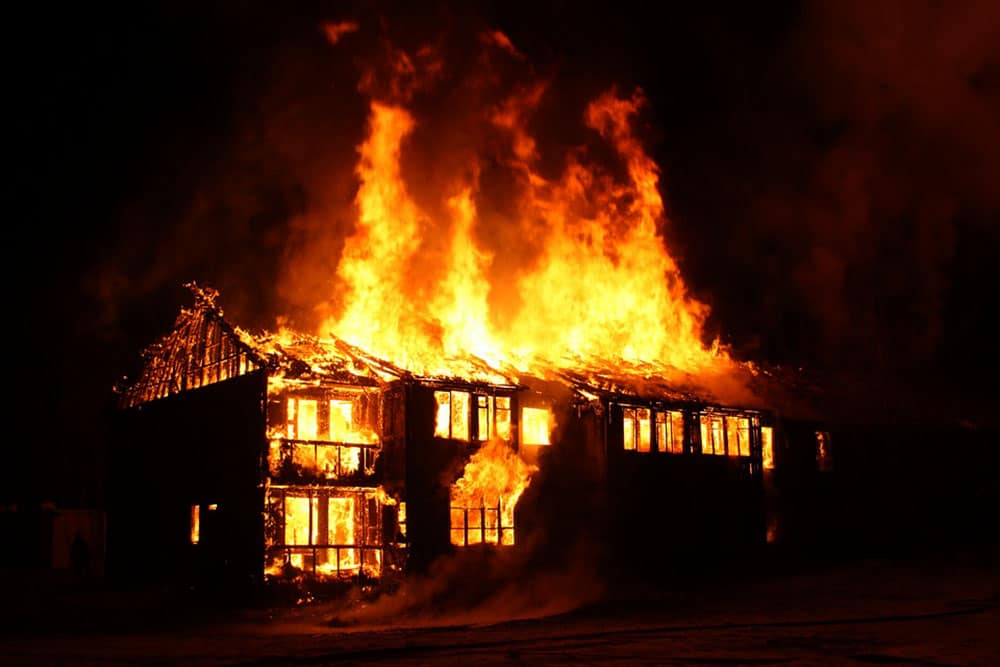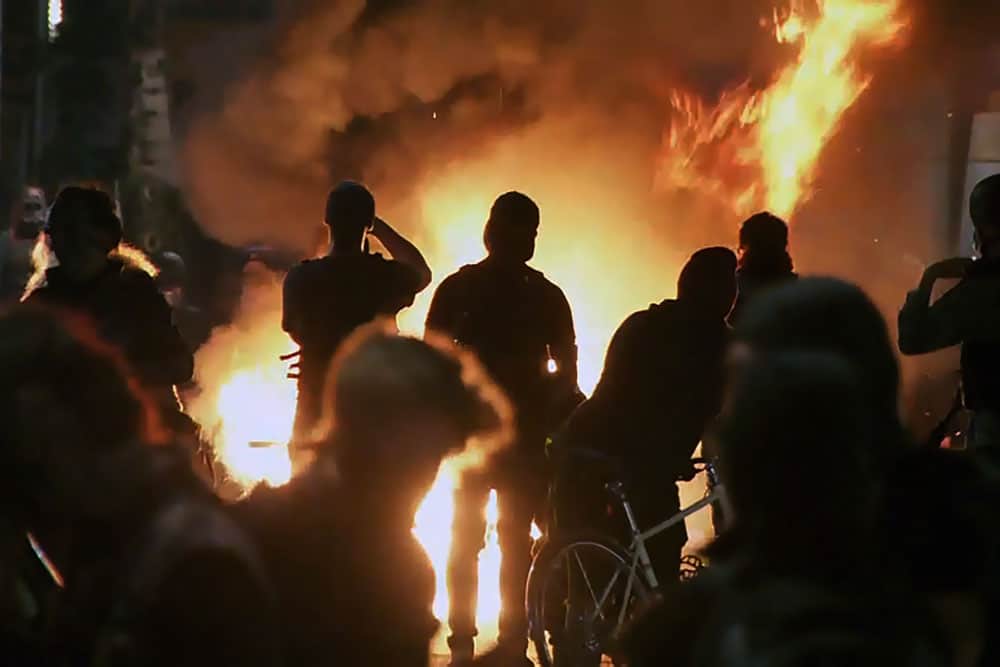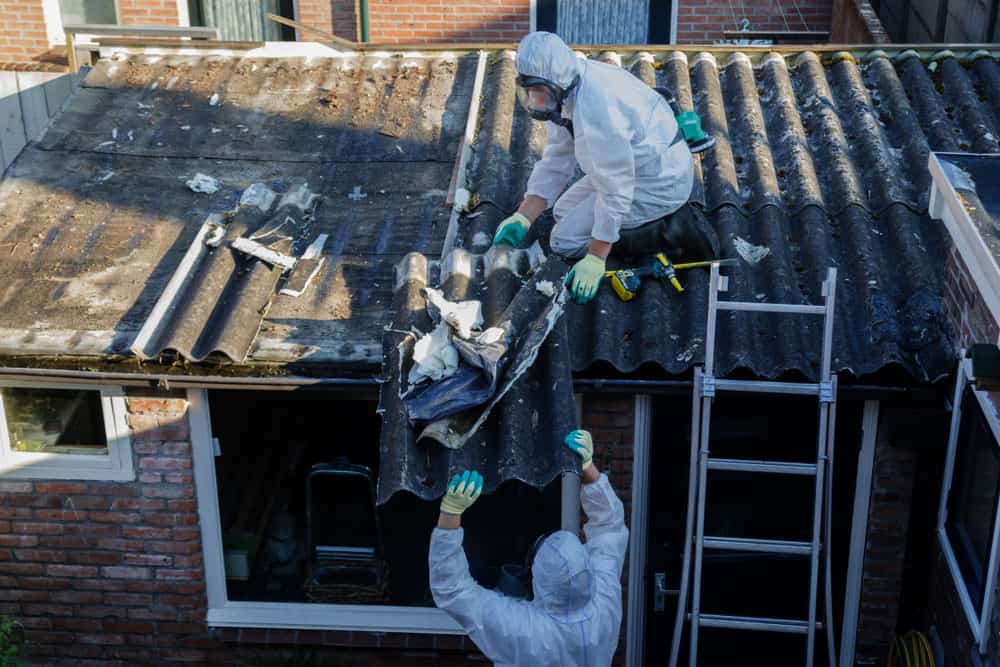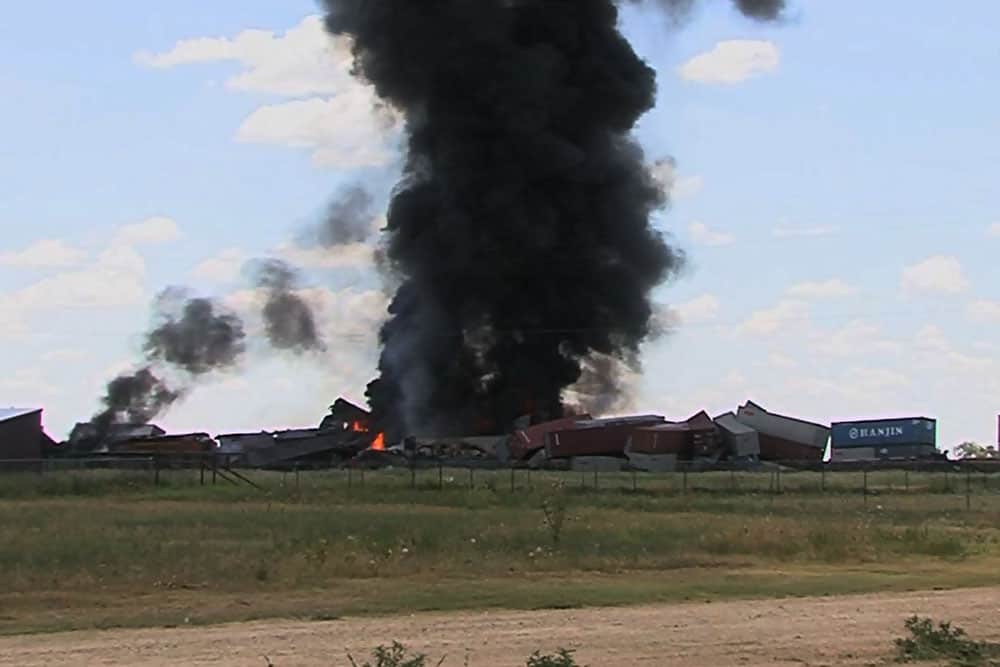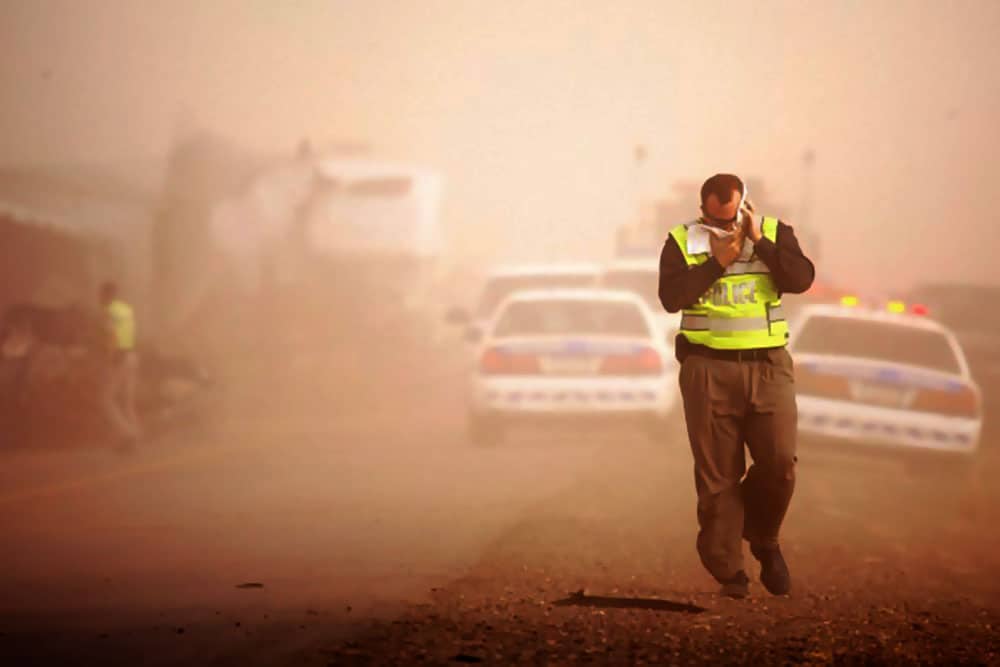The gas mask has become an iconic symbol of an increasingly dangerous world. Over the past year we have been barraged with images of public health workers in hazmat suits and gas masks lumbering through the world’s shopping malls, restaurants and city streets in eerie pics some will no doubt interpret as a harbinger of The End.
But hysterical overreactions aside, this descendant of World War I trench warfare is a necessary component of any real prepper’s survival kit. As we’re about to see it has a variety of real world applications that can help you transcend many grave dangers from house fires to nuclear terrorism. Here are 10 reasons you should own a gas mask.
1. To Protect Against Biological Threats
As we have just seen all too clearly, biological threats are no longer just the stuff of movies. While the corona flu wasn’t exactly apocalyptic in nature it nonetheless made clear to billions of people that a biological agent could be developed in a laboratory in a hostile country and released, either accidentally or on purpose, to devastating effect (1). Imagine if someone were able to weaponize something like ebola?
Fortunately, gas masks can provide front line protection against biological threats. Of course you will need to have the right filters at hand to protect you against airborne viruses. But if you’re going to the trouble of buying a gas mask, or gas masks for your family, you should do your homework and get a variety of filters in order to defend against as many different threats as possible.
2. To Survive a Forest Fire
Drought in the western US has reached historic proportions (2) and it seems every year wildfires claim larger and larger chunks of real estate in places like California. Some of these wildfires can be almost biblical in nature, taking on the form of a literal firestorm that sweeps through an area like a hadean juggernaut. But it’s not just the flames themselves you need to worry about in the event of a wildfire. In many cases, smoke takes people out even when they believe they are a safe distance from the flames.
Smoke from wildfires contains large amounts of carbon monoxide (3), and breathing in this noxious gas can cause death in just a matter of minutes. If you live in a state that is prone to wildfires you owe it to yourself and your family members to have a gas mask or gas masks on hand with plenty of P3 and carbon monoxide filters. These could literally be the difference between life and death for yourself and your loved ones.
3. To Protect Yourself in Case of a House Fire
Every year there are around 350,000 house fires in the US causing more than 2,000 fatalities (4). Most of those fatalities are not the result of heat or flame but of smoke inhalation (5). If there is a fire in your home having a gas mask on hand can be the difference between surviving and perishing. In fact, you should probably have more than one stored in strategic locations throughout the house because you never know where you might be trapped if a fire breaks out.
Keep in mind too that gas masks are too big to fit kids. Therefore, if there are children in the house and a fire breaks out, your ability to don a gas mask may be the only thing that enables you to enter that smoke filled bedroom to rescue your son or daughter. Make sure the gas masks in your home have P3 filters capable of filtering out carbon monoxide as well as smoke.
4. To Protect Yourself From Peaceful Protests
Politics is a contact sport and as we saw in 2020, the potential for civil unrest is never far away here in the USA (6). Under normal circumstances burning and looting and the widespread destruction of businesses typically draws the ire of The Man who often responds with Marxist air freshener, or as most people call it, tear gas.
In the event peaceful protesters move in to wreak havoc on your community it can pay handsome dividends to have a gas mask on hand with full facial coverage and P3 gas masks. That way you can continue to watch your favorite show unperturbed while the clouds of tear gas envelope your house.
5. To Protect Your Lungs in the Event of a Volcanic Eruption
Okay, so this is not a scenario a lot of people in Indiana need to worry about, but many of the tallest peaks on the west coast are volcanic peaks associated with the boundary between the North American and Pacific tectonic plates (7). There are, in fact, 13 volcanic peaks in the Northwest ranging from Mt Baker near the Canadian border in Washington state, to Lassen Peak in northern California.
As Mount St Helens demonstrated in 1980 it’s folly to assume these volcanoes do not represent a threat. When they erupt they can send millions of tons of ash into the air which, if inhaled, can cause a variety of respiratory problems (8). While the odds of an eruption on any given day may be remote, these volcanoes are not extinct and several have erupted in the past 150 years or so.
Of course, if you live in Hawaii, the threat of volcanoes is an everyday affair. For example, Kilauea is one of the world’s most active volcanoes and was in a state of constant eruption for 35 years between 1983 and 2018. Kilauea typically emits what is called “Vog” (9) which is composed of sulfuric acid droplets and other sulfate compounds and is super-fine in nature, meaning it can travel deeply into the lungs causing damage. A gas mask that provides protection against PM2.5 particles can protect against this.
6. To Protect Yourself in Case of Nuclear Attack
Let’s be real, if the nukes start flying in earnest there will be no place to hide. Even if by some miracle you did survive all-out nuclear conflagration the world you’d emerge into wouldn’t sustain you. So a gas mask won’t be much good in the event of World War III. However, with every day that passes the possibility of a nuclear terrorist event becomes more likely and in that case, a gas mask might – might – enable you to survive if you are in the vicinity but far enough from ground zero that you’re not vaporized.
Gas masks and cartridges are available that can provide some protection against the Big 4 threats: Chemical, Biological, Radiological and Nuclear weapons. In the case of nuclear weapons, you’ll want a cartridge to protect you against Alpha and Beta particles. Keep in mind, though, that no mask or cartridge on earth will protect you from gamma radiation emitted during a nuclear event. For that you’ll need to take additional steps (10).
7. To Protect Yourself During Dust Storms
People in New Jersey don’t see a lot of dust storms but if you live in Texas, Oklahoma, Nebraska, Kansas, Colorado, Utah, Nevada, New Mexico, Arizona and even upper tier states like Idaho, dust storms are a part of life. Due to a combination of ongoing drought and rising ocean temperatures, the US southwest is drying out at an alarming rate with one result being an increase in dust storms there (11).
Fortunately, should a dust storm descend you don’t have to wind up with a pound of topsoil in your lungs. A good gas mask with P3 filters should enable you to handle whatever the increasingly dusty earth throws at you. Just remember to get a mask that provides full face coverage because dust storms can be very hard on the eyes.
8. To Protect Yourself on the Job
For a lot of people work means installing insulation, spray painting cars or other items, working in demolition, removing asbestos, working in food processing facilities around lots of powdered ingredients, waterproofing moldy basements and more. If you perform this work for a large established company they will likely provide you with personal protective gear, including a proper mask.
However, if you work for yourself you may be tempted to save a few bucks and just wrap a bandana around your face while spraying paint or installing spray foam insulation. We would urge you to resist this impulse and invest in a proper gas mask with the appropriate filters to handle the particular airborne threat you’ll be dealing with. In the case of working with asbestos that would be a full face gas mask with an N100, R100, or P100 filter.
9. To Protect Against Chemical Spills
Chemical spills happen, just ask the residents of Bopal, India where in 1984 thousands lost their lives and more than a half million were sickened when methyl isocyanate was released from a nearby Union Carbide pesticide plant (12). Exactly how the leak occurred is open to debate but the important take away is that chemicals are a real danger, one the gas masks can help provide protection from, if they’re donned in time.
If you’re tempted to think that toxic chemical spills are a strictly third world problem, think again. In 2019 a train derailment in Georgia released hydrochloric acid and hydrogen peroxide into the atmosphere resulting in the evacuation of nearby area (13). If you live anywhere near an industrial plant or railroad tracks a gas mask should be part of your home preparedness kit.
10. To Protect Your Eyes
We spent most of our time laying out ways to protect your lungs from airborne contaminants. But your lungs are not the only organ that needs protection. Your eyes are pretty important too and if they’re left exposed to various chemical or biological agents you could wind up losing your sight. Which is why, if you’re going to bother to get a gas mask, it should be a full face mask, to protect you against any eventuality.
Gas Mask FAQs
What Are the Odds I’ll Ever Need a Gas Mask?
200 years ago they were basically non-existent, unless you lived near an active volcano. But modern technologies have created uniquely modern problems such as nuclear weapons, the possibility of chemical warfare, accidents involving deadly chemicals, and of course the possibility of a hostile rogue entity releasing a biological agent. As such the odds that you might find yourself in need of a gas mask today are, unfortunately, pretty good.
Some might point to the fact that chemical and biological agents have been banned by various international agreements and protocols. But since when do the power hungry (14), or those who believe they are acting on behalf of some supernatural agent (15), ever abide by such agreements? And we won’t even talk about the growing evidence that the coronavirus is man-made.
But beyond the possibility of a calculated nuclear, biological or chemical attack there are numerous everyday scenarios, as we laid out above, where you would be very happy to have a gas mask at the ready. A gas mask is similar to a first aid kit, you hope you never need but it but will grateful you have one if you do. Even an earthquake can rupture gas lines that could cause toxic gas to escape and a gas mask would be beneficial.
How Does a Gas Mask Work?
With a gas mask the mask itself doesn’t do a whole lot. The ability of the mask to save your bacon when the SHTF is dependent entirely on the filters. Each mask can accommodate either 1 or 2 filters, which are unpackaged and screwed into place when circumstances dictate. All the air you breathe will come through the filters where activated charcoal (16) or some other material will attract or absorb the airborne contaminant before you have a chance to breathe it in. The best filters are capable of trapping more than 99.9% of dangerous particles.
When Should I Put on the Gas Mask?
It depends on the circumstances. In the case of dust storms or volcanic ash you may have some leeway, although you shouldn’t wait if the dust or ash in the air is upon you. If there has been a train derailment in your area with the danger of toxic gases being released, or you learn of a chemical or biological attack, you should put the gas mask on immediately. If you wait until people start dropping around you it may already be too late. Likewise, if your house is on fire and there’s smoke everywhere you should also put it on immediately.
Can I Wear a Gas Mask Indefinitely?
Gas masks aren’t designed to be worn 24 hours a day, but there may be incidents that call for wearing them for a prolonged period of time. For that reason it’s crucial that you stock up on filters, because the filter will be the final arbiter regarding how long your mask is effective. Most standard combined filters will last about 8 hours. Filters designed specifically to protect against certain chemical agents may last as long as 20 hours. But you shouldn’t try and push the envelope unless you have no choice.
What’s Better, A Half Mask or a Full Mask?
In almost all circumstances it’s better to have a full face mask than a half mask that just covers your nose and mouth. Therefore, the full face gas mask should be your default choice with the half masks used as backup, or as your primary only until you are able to locate and procure some full face masks.
A half mask won’t be much use against chemical attack, airborne chemicals resulting from a train wreck, an industrial accident, or even tear gas. Sure you might be able to breathe, but you’re likely to be rendered blind for all intents and purposes. Also, some viruses such as ebola (17) can enter the body through the eyes, so a half mask in that case would be basically useless.
The type of full face gas mask is also important. Some masks have individual lenses for each eye. These, however, can severely restrict your field of vision, which is not a good if you are attempting to beat a hasty retreat from a threat. Many people prefer a large, single pane of glass, as this provides a wide angle view. At the end of the day, though, it’s really up to you.
Do Gas Mask Filters Expire?
They do. And not only that, but as we mentioned above they don’t last that long once pressed into service. This all serves to reinforce the notion that gas masks are intended to be a short term solution to acute problems. Not standard casual wear for the post apocalypse.
Also, gas mask filters don’t really care if there are airborne toxins around or not. As soon as you press them into service the clock begins ticking on their usefulness, even if you’re breathing clean fresh air.
The best course of action is to stock up on all-purpose filters and to augment that stock with some filters designed for specific threats. Keep a record of all your filters as well as their expiration dates and replace them before they reach that date.
Filters aren’t cheap, and stockpiling a bunch will cost you some money. But when the SHTF you’ll be glad you made the investment.
Can I Use an Old Gas Mask and Filters in an Emergency?
If you get caught in a biological attack and it’s either “old mask or nothing” then you can always strap on a vintage mask and hope you get lucky. But that should be the only time you even consider using an old war surplus mask for survival purposes.
Some old masks actually used asbestos as a filtering agent. But even if the old filters weren’t asbestos, if they’re old enough they’ve no doubt begun to degrade, meaning A) you’ll be breathing in pieces of the filter made of who knows what, and B) that filter won’t keep anything out anyway.
Some Final Tips
Tip #1 – If you have facial hair it’s likely it will compromise the fit of the gas mask. This could be a fatal compromise depending on the airborne agent you’re faced with. If you want your gas mask to do its job properly you may have to rethink your beard.
Tip #2 – Practice putting your gas mask on because you may only have seconds to do so in the event of an emergency. It should become 2nd nature to you. If it’s not, they may find your body with the mask still in your hand.
Tip #3 – Don’t expect the gas mask to be comfortable. It shouldn’t hurt to wear it, but a gas mask is a big cumbersome appliance and it’s not going to feel great, especially if you have to wear it for hours at a time. So just be aware of that.
Tip #4 – Pulling air through gas mask filters is not like normal breathing. It can take some work. So if you need to bug out with your gas mask on try to temper your actions because you may not be able to draw enough air to, say, run flat out for an extended period of time without passing out.
Tip #5 – Gas masks trap air inside against your face. If it’s hot outside it’s going to be even hotter inside the mask. If you’re exerting yourself too hard and sweating profusely it could compromise the seal of the mask on your face. Try not to do that.
Tip #6 – It seems strange that there aren’t universal threading standards for gas mask filters, but there aren’t. Therefore, always make sure the threads on the filters you buy are compatible with the threads on your mask. Don’t wait until the cloud of sarin gas is headed your way to figure this out.
Tip #7 – Be careful how you store your gas mask filters. You may have to purchase a special container to store them in to prevent them from absorbing airborne particles while they’re waiting to be used. Some filters come with a protective cap over them, that prevents this incidental absorption. But if yours don’t, make sure you store them properly in a secure airtight container. And always keep an eye on the expiration dates as we mentioned earlier.


